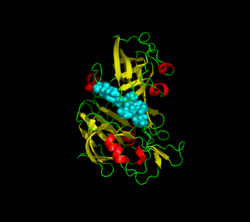Biology:Plasmepsin
| Plasmepsin I | |||||||||
|---|---|---|---|---|---|---|---|---|---|
| Identifiers | |||||||||
| EC number | 3.4.23.38 | ||||||||
| CAS number | 180189-87-1 | ||||||||
| Databases | |||||||||
| IntEnz | IntEnz view | ||||||||
| BRENDA | BRENDA entry | ||||||||
| ExPASy | NiceZyme view | ||||||||
| KEGG | KEGG entry | ||||||||
| MetaCyc | metabolic pathway | ||||||||
| PRIAM | profile | ||||||||
| PDB structures | RCSB PDB PDBe PDBsum | ||||||||
| |||||||||
| Plasmepsin II | |||||||||
|---|---|---|---|---|---|---|---|---|---|
 | |||||||||
| Identifiers | |||||||||
| EC number | 3.4.23.39 | ||||||||
| CAS number | 159447-18-4 | ||||||||
| Databases | |||||||||
| IntEnz | IntEnz view | ||||||||
| BRENDA | BRENDA entry | ||||||||
| ExPASy | NiceZyme view | ||||||||
| KEGG | KEGG entry | ||||||||
| MetaCyc | metabolic pathway | ||||||||
| PRIAM | profile | ||||||||
| PDB structures | RCSB PDB PDBe PDBsum | ||||||||
| |||||||||
Plasmepsins are a class of at least 10 enzymes (EC 3.4.23.38 and EC 3.4.23.39) produced by the Plasmodium falciparum parasite. There are ten different isoforms of these proteins and ten genes coding them respectively in Plasmodium (Plm I, II, III, IV, V, VI, VII, IX, X and HAP). It has been suggested that the plasmepsin family is smaller in other human Plasmodium species. Expression of Plm I, II, IV, V, IX, X and HAP occurs in the erythrocytic cycle, and expression of Plm VI, VII, VIII, occurs in the exoerythrocytic cycle. Through their haemoglobin-degrading activity, they are an important cause of symptoms in malaria sufferers. Consequently, this family of enzymes is a potential target for antimalarial drugs.
Plasmepsins are aspartic acid proteases, meaning their active site contains two aspartic acid residues. These two aspartic acid residue act respectively as proton donor and proton acceptor, catalysing the hydrolysis of peptide bond in proteins.
There are four types of plasmepsins, closely related but varying in the specificity of cleavage site. Plasmepsins I and II cleave hemoglobin between residues Phenylalanine 33 and Leucine 34 of α-globin subunit.
The name plasmepsin may come from Plasmodium (the organism) and pepsin (a common aspartic acid protease with similar molecular structure).
The closest (non-pathogenic) enzymatic equivalent in humans is the beta-secretase enzyme.
References
- ↑ "Structure and inhibition of plasmepsin II, a hemoglobin-degrading enzyme from Plasmodium falciparum". Proc. Natl. Acad. Sci. U.S.A. 93 (19): 10034–9. September 1996. doi:10.1073/pnas.93.19.10034. PMID 8816746. Bibcode: 1996PNAS...9310034S.
Further reading
- "Sequence, expression and modeled structure of an aspartic proteinase from the human malaria parasite Plasmodium falciparum". Mol. Biochem. Parasitol. 64 (2): 177–90. 1994. doi:10.1016/0166-6851(94)90024-8. PMID 7935597.
- "Crystal structure of the novel aspartic proteinase zymogen proplasmepsin II from plasmodium falciparum". Nat. Struct. Biol. 6 (1): 32–7. 1999. doi:10.1038/4905. PMID 9886289.
- "Flap Dynamics of Plasmepsin Proteases: Proposed Parameters and Molecular Dynamics Insight". Mol. Biosyst. 11 (4): 1061–1066. 2015. doi:10.1039/C4MB00631C. PMID 25630418.
External links
- The MEROPS online database for peptidases and their inhibitors: Plasmepsin I A01.022, Plasmepsin II A01.023
- plasmepsin at the US National Library of Medicine Medical Subject Headings (MeSH)
 |

